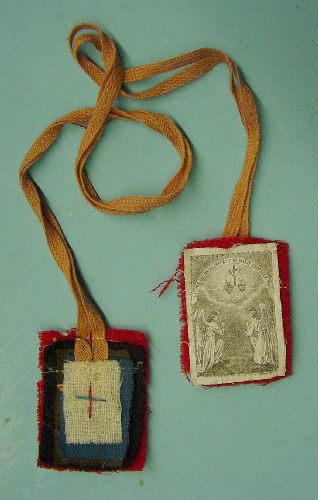|
The scapular originated from the cloak of the Carmelite Order's garb in the Middle Ages. The robe showed images of Our Lady of Carmel and the Heart of Jesus, for protection against evil.
Pope John XXII. announced on 03.03.1322 in the Bull Sabbatina, the Blessed Mother had promised who wears the scapular, observes the befitting chastity, prays every day the little Marian times of the day and fasting on Wednesday / Friday / Saturday (eating no meat) Get rid of purgatory Saturday after his death. Pope Pius X recognized this bull on 16.12.1910 and explicitly extended this privilege to those who wear a consecrated medal instead of the fabric shredder.
In the rich treasure of the Sacramentals of the Holy Church, there are several scapulars of various orders. But the most important - and most widespread - is the brown scapular of Mount Carmel. The five-fold Scapular (according to the Blessing in Roman Ritual) contains the following scapulars:
- the white scapular of the Trinitarians
- the red scapular of the Passion of Jesus
- the blue scapular of the Immaculate Conception
- the black scapular of the Servants of Mary (Servites)
- the brown scapular of Our Lady of Mount Carmel (real woven wool!)
This big scapular can not be replaced by a medal.
In some places, once every child and almost every adult wore a scapular, with the children a "simple", the adults mostly a "five-fold" had. The simple scapulars were consecrated on the "Skapuliersonntag", the Sunday after July 16, by the local pastor in the church, the adult capuliers, however, were mostly consecrated by the penitents in the missions or distributed by Kapuzinerpatres. These scapulars were worn around the neck and were designed to protect against misfortune, danger and all evil spirits. The scapular amulets have occasionally been used in folk medicine to help the patient make a decision - either to die quickly and without wasting time - or to heal quickly, but not so.
"Fourthly, when one brings such a picture to the sick, at whom they doubt whether to die or recover: and, once upon a time, such things, or hung up on them, the sick have soon changed to dying, or living been.
The scapular was also used to facilitate heavy births and thus took on the role of the rarer St. Margaret's bands ...
"Fifth, it has helped in different diseases, when such picture Mariae was laid out, especially to those hard-hitting women, when they were put to them the picture on the hertz, and roused the same with devotion".
(L. Hansmann, amulets, magic, talisman, Nikolverlag Hamburg 1999. p. 189).
If you look at the history of the Munshausen church, you must also mention the more than 300 years old veneration of Our Lady of Mount Carmel (Our Lady of the Scapular). The Scapular Brotherhood, founded in 1671 during the difficult years of the plague, lives on to the present day, albeit on the back burner. "He who wears a scapular on his skin will not die a sudden death" (Lux, Land 1884 p.528) (cit Pol Tousch, Of Customs, Morals and Superstitions, RTL Edition, 1985).
According to an old custom one should not take off the ribbon once it has been created. It offers protection against mischief, brings happiness and inner contentment. If the ribbon becomes brittle and falls off, the wearer fulfills a wish ...
Parallel object
Lice sacs (Laüseseckli, Luusbündeli) are small, often heart-shaped bundles of tissue, which are usually filled with blessed hay flowers. The infants are placed in the cradle for protection from vermin or stapled on the dress on the left shoulder. The Läusesäcklein were here and there produced in women's monasteries and brought by the Capuchin monks among the people. Usually as a gift for donations. Here are parallels to the "scapulars" obvious. The best lice bags were filled with palmgrass (nodding perl grass, Melica nutans) whose seeds look like lice. The grass / seed was therefore the object of protection against lice: similia similibus.
|




